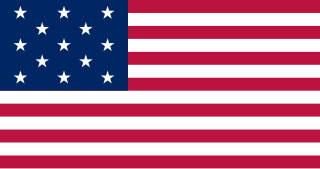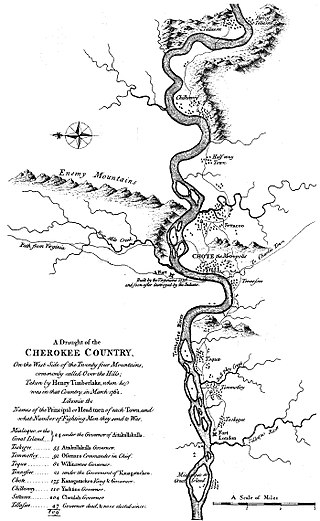Related Research Articles

The Territory South of the River Ohio, more commonly known as the Southwest Territory or the old Southwest Territory, was an organized incorporated territory of the United States that existed from May 26, 1790, until June 1, 1796, when it was admitted to the United States as the State of Tennessee. The Southwest Territory was created by the Southwest Ordinance which was similar to the previous two ordinances passed by the Confederation Congress for the parallel establishment and development of the old Northwest Territory of 1786-1803. It pertained to lands situated north of the Ohio River, around the Great Lakes and extending west to the Mississippi River. The lands of the Territory were taken from western areas beyond the mountains of the Commonwealth of Virginia (later to be separated and erected into the new 15th state of the Commonwealth of Kentucky. Western lands were also ceded by the state of North Carolina from lands of the Washington District that had been already ceded to the U.S. federal government by North Carolina.
Liberty! The Saga of Sycamore Shoals, formerly known as The Wataugans, is an outdoor historical drama that takes place in Elizabethton, Tennessee, at the Sycamore Shoals Historic Area. Designated the official outdoor drama of the state of Tennessee, it is presented by the Friends of Sycamore Shoals every June each night of the first four weekends. Employing a mixed cast of volunteering professional and amateur local actors and re-enactors engaged through an open casting call, Liberty depicts the early history of the area that is now northeast Tennessee.

John Sevier was an American soldier, frontiersman, and politician, and one of the founding fathers of the State of Tennessee. A member of the Democratic-Republican Party, he played a leading role in Tennessee's pre-statehood period, both militarily and politically, and he was elected the state's first governor in 1796. He served as a colonel of the Washington District Regiment in the Battle of Kings Mountain in 1780, and he commanded the frontier militia in dozens of battles against the Cherokee in the 1780s and 1790s.
Dragging Canoe was a Cherokee red chief who led a band of Cherokee warriors who resisted colonists and United States settlers in the Upper South. During the American Revolution and afterward, Dragging Canoe's forces were sometimes joined by Upper Muskogee, Chickasaw, Shawnee, and Indians from other tribes, along with British Loyalists, and agents of France and Spain. The Cherokee American Wars lasted more than a decade after the end of the American Revolutionary War.

Nanyehi, known in English as Nancy Ward, was a Beloved Woman and political leader of the Cherokee. She advocated for peaceful coexistence with European Americans and, late in life, spoke out for Cherokee retention of tribal hunting lands. She is credited with the introduction of dairy products to the Cherokee economy.
The Nickajack Expedition in 1794 was a long-running battle fought from late summer to fall between American frontiersmen and the Chickamauga Cherokee. This Cherokee band had resisted the increasing American encroachment into their territory and raided American settlements in the region.

The western theater of the American Revolutionary War (1775–1783) was the area of conflict west of the Appalachian Mountains, the region which became the Northwest Territory of the United States as well as what would become the states of Arkansas, Kentucky, Louisiana, Missouri, and Tennessee. The western war was fought between American Indians with their British allies in Detroit, and American settlers south and east of the Ohio River, and also the Spanish as allies of the latter.

The Overmountain Men were American frontiersmen from west of the Blue Ridge Mountains which are the leading edge of the Appalachian Mountains, who took part in the American Revolutionary War. While they were present at multiple engagements in the war's southern campaign, they are best known for their role in the American victory at the Battle of Kings Mountain in 1780. The term "overmountain" arose because their settlements were west of, or "over", the Blue Ridge, which was the primary geographical boundary dividing several of the 13 American states from the Native American lands to the west. The Overmountain Men hailed from parts of Virginia, North Carolina, and what is now Tennessee and Kentucky.

Fort Nashborough, also known as Fort Bluff, Bluff Station, French Lick Fort, Cumberland River Fort and other names, was the stockade established in early 1779 in the French Lick area of the Cumberland River valley, as a forerunner to the settlement that would become the city of Nashville, Tennessee. The fort was not a military garrison. The log stockade was square in shape and covered 2 acres (8,100 m2). It contained 20 log cabins and was protection for the settlers against wild animals and Indians. James Robertson and John Donelson are considered the founders, and colloquially, the "founders of Tennessee". The fort was abandoned in 1794, but the settlement, now the city of Nashville, became the capital of the new state of Tennessee in 1843.

The Sycamore Shoals of the Watauga River, usually shortened to Sycamore Shoals, is a rocky stretch of river rapids along the Watauga River in Elizabethton, Tennessee. Archeological excavations have found Native Americans lived near the shoals since prehistoric times, and Cherokees gathered there. As Europeans began settling the Trans-Appalachian frontier, the shoals proved strategic militarily, as well as shaped the economies of Tennessee and Kentucky. Today, the shoals are protected as a National Historic Landmark and are maintained as part of Sycamore Shoals State Historic Park.

The Cherokee–American wars, also known as the Chickamauga Wars, were a series of raids, campaigns, ambushes, minor skirmishes, and several full-scale frontier battles in the Old Southwest from 1776 to 1794 between the Cherokee and American settlers on the frontier. Most of the events took place in the Upper South region. While the fighting stretched across the entire period, there were extended periods with little or no action.

Fort Watauga, also known as Fort Caswell, was a fortification located in the Watauga River's Sycamore Shoals near modern-day Elizabethton, Tennessee. It was constructed from 1775 to 1776 by the Watauga Association, a semi-autonomous government founded by American settlers living near the river, to defend the settlers against attacks from British-allied Indians. The fort was originally named Fort Caswell after the governor of North Carolina, Richard Caswell.

Long Island, also known as Long Island of the Holston, is an island in the Holston River at Kingsport in East Tennessee. Important in regional history since pre-colonial times, the island is listed on the National Register of Historic Places and is designated as a U.S. National Historic Landmark District.

Sycamore Shoals State Historic Park is a state park located in Elizabethton, in the U.S. state of Tennessee. The park consists of 70 acres (28.3 ha) situated along the Sycamore Shoals of the Watauga River, a National Historic Landmark where a series of events critical to the establishment of the states of Tennessee and Kentucky, and the settlement of the Trans-Appalachian frontier in general, took place. Along with the historic shoals, the park includes a visitor center and museum, the reconstructed Fort Watauga, the Carter House and Sabine Hill . For over a thousand years before the arrival of European explorers, Sycamore Shoals and adjacent lands had been inhabited by Native Americans. The first permanent European settlers arrived in 1770, and established the Watauga Association—one of the first written constitutional governments west of the Appalachian Mountains—in 1772. Richard Henderson and Daniel Boone negotiated the Treaty of Sycamore Shoals in 1775, which saw the sale of millions of acres of Cherokee lands in Kentucky and Tennessee and led to the building of the Wilderness Road. During the American Revolution, Sycamore Shoals was both the site of Fort Watauga, where part of a Cherokee invasion was thwarted in 1776, and the mustering ground for the Overmountain Men in 1780.

Overhill Cherokee was the term for the Cherokee people located in their historic settlements in what is now the U.S. state of Tennessee in the Southeastern United States, on the western side of the Appalachian Mountains. This name was used by 18th-century European traders and explorers from British colonies along the Atlantic coast, as they had to cross the mountains to reach these settlements.
Old Tassel — Reyetaeh in Cherokee language, Koatohee, sometimes Corntassel — was "First Beloved Man" of the Overhill Cherokee after 1783, when the United States gained independence from Great Britain. He worked to try to keep the Cherokee people of the Overhill region out of the Cherokee–American wars being fought between the European-American frontiersmen and the Chickamauga band warriors led by Dragging Canoe. He was murdered in 1788 along with another chief at Chilhowee by white settlers under a flag of truce.
Savanukahwn (Cherokee) was known as the Raven of Chota in the late 18th century. The nephew of Oconostota, he became First Beloved Man of the Cherokee in the fall of 1781. He was ousted by the elders of the Overhill towns in 1783 in favor of the more pacifist Old Tassel.
John Watts, also known as Young Tassel, was one of the leaders of the Chickamauga Cherokee during the Cherokee–American wars. Watts became particularly active in the fighting after frontiersmen murdered his uncle, Old Tassel (1708–1788), in 1788.

The Path Grant Deed is a document regarded as a first step toward the American westward migration across the Appalachian Mountains, resulting from negotiations at Sycamore Shoals in March 1775. The land acquired within the boundaries of the Path Grant allowed Daniel Boone to develop the Wilderness Road free from attack or claims by the Cherokee. The Path Grant was recorded on November 15, 1794, by the Hawkins County, Tennessee registrar in Deed Book #1, pages 147-151
The Rutherford Light Horse expedition was a punitive military excursion launched against the Lower, Middle, and Overhill Cherokee settlements of the Cherokee Indians in the Appalachian region of North Carolina. This was in retaliation for the Native Indian attacks made against the European American settlements of the Watauga Association in July 1776, in an early action of the American War of Independence. The expedition, which took place on the American frontier and resulted in the destruction of six Cherokee towns, ran from October 17 until November 16, 1776. The adventure only concluded when the troop was forced to turn back due to a lack of supplies. It was led by Captain William Moore of the 2nd Rowan County Regiment, acting directly under the command of Brigadier General Griffith Rutherford.
References
- ↑ Calloway, Colin G.; The American Revolution in Indian Country : Crisis and diversity in Native American communities ; Cambridge University Press, (1995); ISBN 0-521-47149-4
- 1 2 Rhoden, Nancy L. (2000). The Human Tradition in the American Revolution. Wilmington, Del.: Scholarly Resources Inc. ISBN 978-0842027489.
- 1 2 3 4 Cole, William Samuel; History of Tennessee during the Revolutionary War; pp. 174, 238–239, 286; retrieved March 10, 2023
- ↑ National Archives : To George Washington from Piomingo, 30 October 1789 [letter not found; created May, 4, 2002; perma-link; National Archives website; "Founders Online;" Source Project: Washington Papers; retrieved March 9, 2023
- 1 2 3 4 5 Store, Lynn; Battle of Island Flats; Discover Kingsport online; retrieved February 2023
- 1 2 Lynch, Wayne; William Cocke at the Battle of Long Island Flats, 1776; "Journal of the American Revolution"; [via WebPage; May 7, 2013; All Things Liberty online]; retrieved March 2023
- 1 2 Roosevelt, Theodore (1917-01-01). The Winning of the West: An Account of the Exploration and Settlement of Our Country from the Alleghanies to the Pacific. G. P. Putnam's sons.